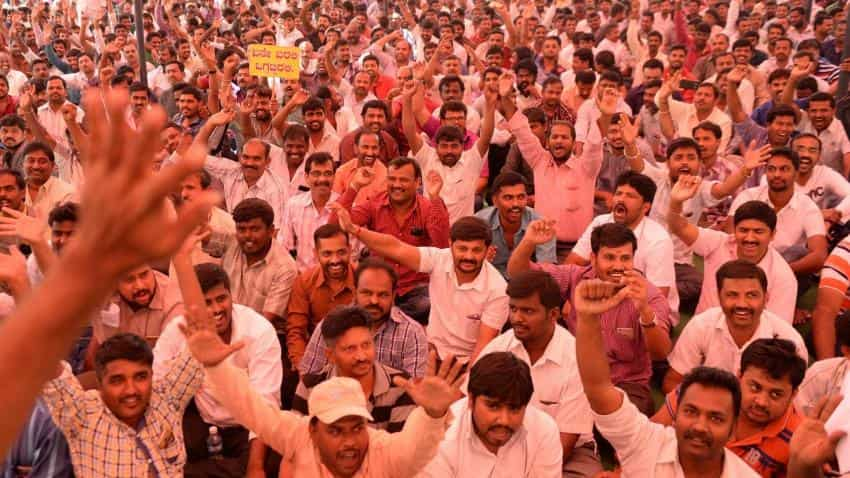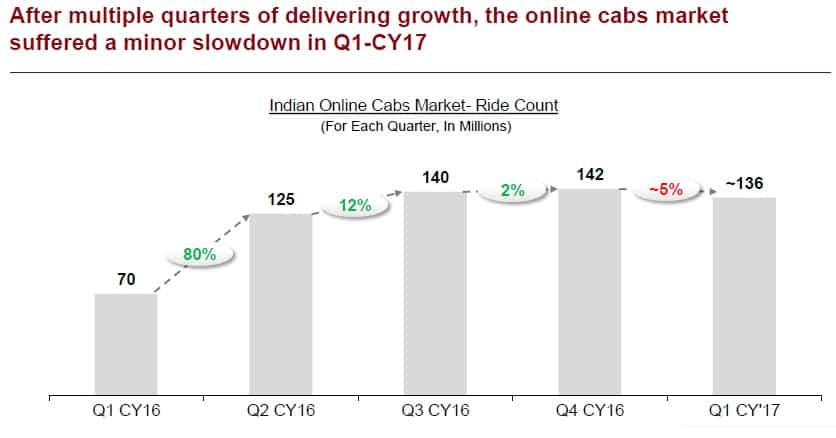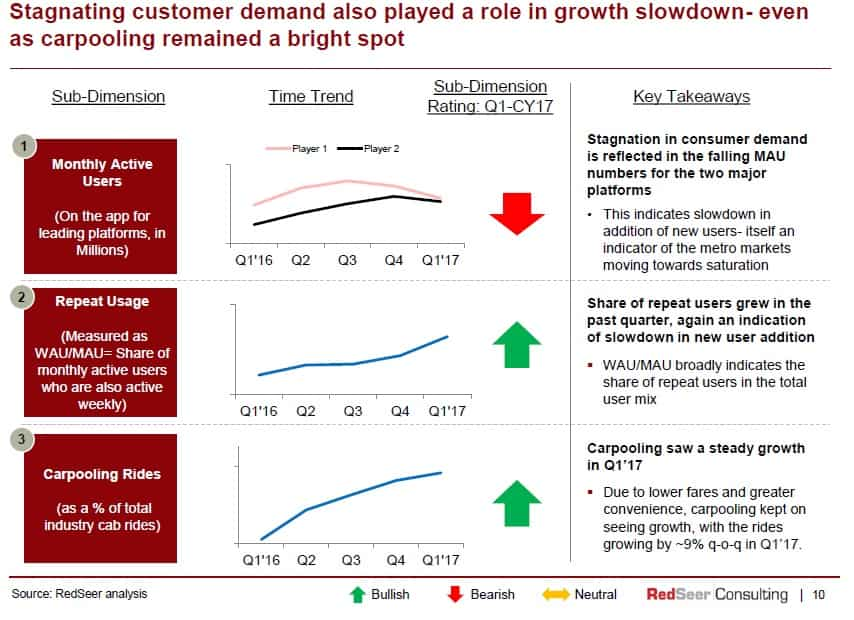Bookings on Ola, Uber decline for the first time in India; is the dream-run over?
Online cab bookings in India saw an overall decline for the first time in India due to the impact of drivers going on strikes in major cities thereby disrupting the services.

Key highlights:
- 5% decline in the overall cab booking for the industry in Q1 2017
- Driver strikes due to low incentives resulted in lower bookings
- Driver income declined by 45% quarter on quarter
The Indian online cab market, led by Ola and Uber, has taken a hit so much so that cab bookings declined for the first time in the first three months of this year.
RedSeer Consulting data show that there was a 5% decline in the overall cab bookings for the industry in Q1 2017. This is a first decline in app-based cab bookings in India.

Source: RedSeer Counsulting
Online cab bookings increased by 80% from Q1 2016 to Q2 2016. It further increased by 12% in Q3 2016 and by 2% in Q4 2016., RedSeer said.
Past one year has been tumultuous for Ola and Uber with the two hit by driver agitations and Uber being entangled in a serious issue where a driver raped a customer in Delhi and the company's top executive was found with her medial report allegedly illegally.
Moreover, the two have started trimming incentives that they offered to their drivers significantly impacting earnings of their drivers.
ALSO READ: Uber drivers in India make more money than an average Indian
The report noted that driver income declined by 45% quarter on quarter (QoQ) due to a sharp reduction in ride incentives, by the online cab companies to push profitability.
The report says that first three months of this calendar year were marked by a clear tussle between growth and profitability. “Growing focus on profitability pushed players to cut down on driver incentives - a move which led to driver strikes across India, with the associated supply crunch contributing to a fall in rides for the industry,” it said.
The main two reasons for the decline in overall cab booking growth in India was due to the supply crunch caused due to driver strikes across major cities in India in January and February and the dropping of the consumer demand in terms of monthly active users for leading players.
ALSO READ: Dreams of Ola, Uber drivers crash as incentives trickle and loans catch up
There was a drop in supply of cabs as many drivers chose to leave the online platforms and shift into other offline driving jobs or changed professions entirely, says the RedSeer report.
Both the Indian online cab players saw a stagnation in consumer demand with the falling Monthly Active Users (MAUs). This indicates a slowdown in the addition of new users itself which is an indication of the metro markets moving towards saturation, RedSeer said.

Source: RedSeer Consulting
While there has been a decline in new user growth of both these players, there was however an increase in carpooling rides and repeat users.
The share of repeat users grew in the past quarter which again is an indication of the slowdown in new user growth. There was a large increase in repeat users in Q1 2017 in comparison to the previous quarter.
With Ola now starting its carpooling services after UberPool's success, carpooling saw a steady growth of 9% QoQ in Q1 2017. This was due to lower fares and greater convenience, said the report.
However, there is some good news for Ola and Uber.
While the market declined, there was an improvement in unit economics as shown by a strong drop in driver incentives spending. By cutting spending on driver incentives sharply in the past quarter it pushed the profitability of online cab players.
ALSO READ: Will drive towards profitability halt the ahead for taxi-hailing apps?
The report also pointed out that there was a minor decline in the share of cashless rides. “With the economy slowly recovering from demonetisation and an increase in liquidity in the market has resulted in a slight increase in cash as a mode of payment,” it said.

Source: RedSeer Consulting
The drivers going on strike also meant that the expected time of arrival (ETA) declined slightly in the past quarter due to the supply crunch caused by the strikes. New Delhi and Bengaluru saw a major increase in ETA due to the massive supply crunch in Q1 2017.
India however still is expected to see a large growth in online booked trips as there was a three times growth in rides from 2015 to 2016. This is expected to increase by 5 times by 2020 as it will grow to 150-170 million, expects the report.
Get Latest Business News, Stock Market Updates and Videos; Check your tax outgo through Income Tax Calculator and save money through our Personal Finance coverage. Check Business Breaking News Live on Zee Business Twitter and Facebook. Subscribe on YouTube.
RECOMMENDED STORIES

Senior Citizen Latest FD Rates: Know what major banks like SBI, PNB, Canara Bank, HDFC Bank, ICICI Bank are providing on fixed deposits

Gratuity Calculator: Rs 38,000 as last-drawn basic salary, 5 years and 5 months of service; what will be gratuity amount?

EPFO Pension Schemes: Early pension, retirement pension, nominee pension and 4 other pension schemes that every private sector employee should know

Top 5 Small Cap Mutual Funds with best SIP returns in 1 year: See how Rs 25,000 monthly investment has grown in each scheme

Top 7 SBI Mutual Funds With Best SIP Returns in 1 Year: Rs 25,000 monthly SIP investment in No.1 fund has jumped to Rs 3,58,404
09:44 AM IST











 Dreams of Ola, Uber drivers crash as incentives trickle and loans catch up
Dreams of Ola, Uber drivers crash as incentives trickle and loans catch up Ola, Uber drivers might remain off road tomorrow
Ola, Uber drivers might remain off road tomorrow Drivers make at least Rs 1,500 a day on our platform, Uber says
Drivers make at least Rs 1,500 a day on our platform, Uber says Ola signs MoU with NSDC to train drivers; to invest Rs 100 crore in skill development
Ola signs MoU with NSDC to train drivers; to invest Rs 100 crore in skill development Uber drivers in India make more money than an average Indian
Uber drivers in India make more money than an average Indian